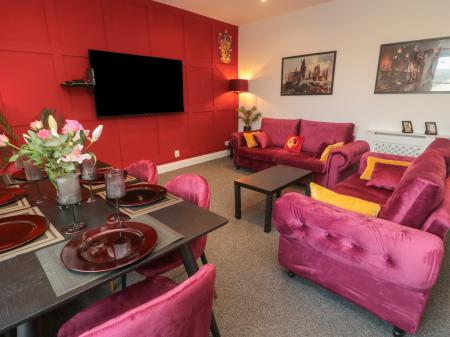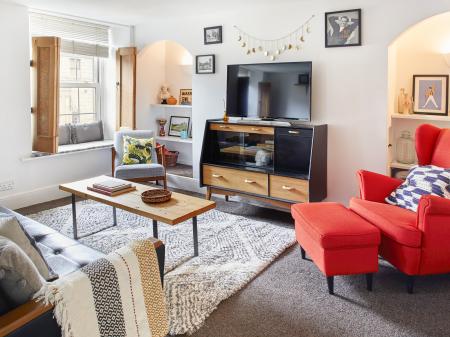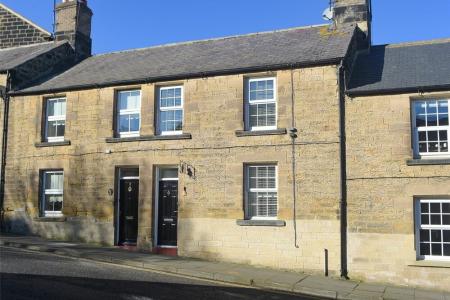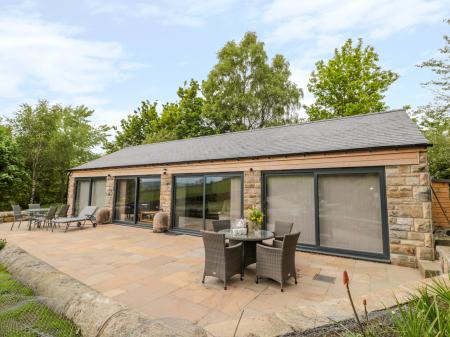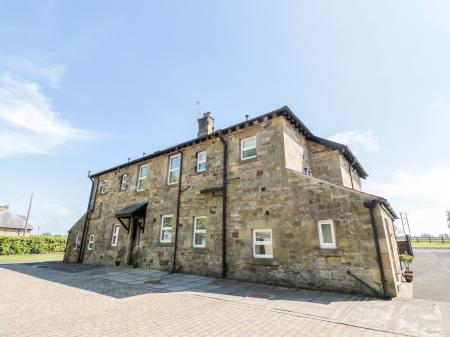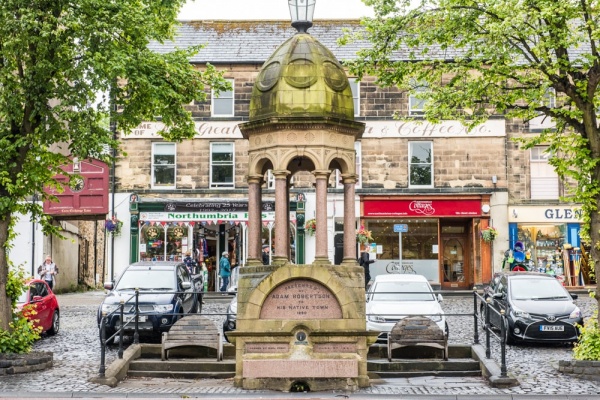
History
The history of Alnwick goes back to the 7th century, but the town really began to develop after Alnwick Castle was built on a manmade motte overlooking the river. The town was subject to frequent raids by the Scots, and as a result, it was granted the right to enclose the entire town within a high wall. The medieval town walls were pierced by four gates. Two have disappeared, but two of the gates remain.
Perhaps the most impressive is Pottergate Tower, which, naturally enough, stands at the top of Pottergate. The medieval structure was rebuilt in Gothick style in 1768. The interior of Pottergate Tower has been transformed to create a luxury holiday cottage. The tower stands near the site of a large cockpit, one of a dozen such pits around Alnwick.

The other medieval gateway is Bondgate, built in the 15th century by the Earl of Northumberland. This three-storey tower is pierced by a central arch still used by modern traffic. Above the central arch, you can make out the very worn outline of a Percy lion symbol. Bondgate separated the areas known as Bondgate Within (inside the walls) and Bondgate Without (outside the walls).
Two 17th century bridges still bring traffic into Alnwick. One of these is the Lion Bridge, so named for the lead statue of a lion - the symbol of the Percy family - adorning one of the central arches.
Alnwick Castle
Alnwick Castle is the ancestral home of the powerful Percy family. The castle is of Norman origin but was restored in the Victorian period. The interiors are a fascinating mix of a medieval fortress and a sumptuous Victorian stately home, with Italianate interiors in High Renaissance style.
There has been a fortress by the River Aln since at least the 11th century and finds of Roman coins suggest that the site was settled long before then. We know that a man named Bisbright Tisonne owned the land here before the Norman invasion.
William the Conqueror gave the land to Gilbert de Tesson, his standard-bearer at the Battle of Hastings. A later Tesson, or Tyson, rebelled against the crown, and William II gave Alnwick to a Norman noble named Ivo de Vesci.
It was Vesci who built the first castle at Alnwick. That first fortress was a simple motte and bailey castle of timber and earth. The line of Vesci lords died out in 1297 and a dozen years later the barony was purchased by Lord Henry Percy, beginning the long, unbroken link between Alnwick and the Percy family.
Beside the castle is Alnwick Garden, a stunning modern garden created by the Duchess of Northumberland. The gardens include the largest collection of European plants in the UK, laid out in a landscape combining water features and modern sculpture.
Alnwick Abbey
In 1304 a monastery was established by Eustace Fitz John for Premonstratensian canons from Newhouse Abbey in Lincolnshire. It was never a large monastery, but the Abbot was influential enough to be called to several parliaments in the reign of Edward I. Perhaps the most famous episode in the history of Alnwick Abbey took place in 1376 when Abbot Walter de Hepescotes hosted a feast for 120 leading nobles and over 1,000 commoners.
The abbey gatehouse stands in Hulne Park, owned by Alnwick Castle estate but open to the public for waymarked walks along the River Aln. One of those waymarked walks leads to the ruins of Hulne Priory.

Hulne Priory
Hulne Priory was established in 1240 by Ralph Fresborn and may have been the first Carmelite monastery in England. The monastic buildings stand within a high retaining wall, a reminder that Northumberland was a battleground between English and Scots throughout much of the medieval period. Within the wall is a pele, or fortified tower, where the monks would take refuge during times of trouble. The tower was a gift from Henry Percy, the 4th Earl of Northumberland.
Bailiffgate Museum
This intriguing museum, housed in a 19th-century church, stands just a few steps from the entrance to Alnwick Castle. The museum tells the story of Alnwick and the surrounding region, including the fascinating history of 'Rothbury Football', played between residents of Rothbury and Thropton, using Thropton bridge as one 'goal' and the porch of Rothbury's parish church as the other. Bailiffgate Museum also tells the story of the Alnwick Wait, a civic official who combined the jobs of a night watchman and a town musician.
St Michael's Church
Alnwick's beautiful parish church dates to the middle of the 12th century. It was rebuilt in Perpendicular style in the 15th century and restored by Anthony Salvin in 1863. Highlights within the church include a stone effigy of Lady Isabella de Vesci, widow of the last Baron Vesci, who died around 1314.
In St Catherine's Chapel is a beautifully carved capital known as 'The Hotspur Capital'. It commemorates Henry 'Hotspur' Percy, fourth son of the 4th Lord Percy, who died at the Battle of Shrewsbury in 1403. In the south-east corner of St Michael's is an unusual lookout used to warn of approaching raiders during the turbulent medieval period.
Dirty Bottles Pub
On Narrowgate is a pub with an unusual name, The Dirty Bottles. It was formerly known as Ye Old Cross Inn and was built in the 17th century. The odd name comes from centuries-old bottles standing in a bow window. Legend has it that the 18th-century landlord of the pub moved one of the bottles and immediately dropped dead.
The publican's widow declared that anyone who touched the bottles would suffer the same fate. So for two centuries, the bottles have lain untouched, under accumulating layers of grime, and no one dares disturb them. The rest of the pub is fully renovated and makes a lovely place for a pint or a meal, but you can see the bottles themselves through the old window.
Almost directly across from the Dirty Bottles pub is a small park featuring a statue of Henry 'Hotspur' Percy. Hotspur gained his moniker for his impetuous, hot-headed actions in battle. He was a fearsome warrior, but not always the wisest. He died in battle when he raised his visor to get some air.
One of the most recent additions to the Alnwick landscape is the award-winning Alnwick Garden, a contemporary garden mixing sculpture, design, and horticulture in a fascinating way, and featuring the world's largest treehouse.

One popular destination for visitors to Alnwick is Barter Books, one of the largest - and quirkiest - bookstores in England. How many other bookshops have a model railway running through the stacks of books? There is a playroom to occupy children while parents browse.
Looking down on Barter Books is the Percy Tenantry Column, a slender stone column topped by a Percy lion. The memorial was erected in 1816 by tenants of the 2nd Duke of Northumberland to thank him for lowering their rents. The column was designed by architect David Stephenson of Newcastle and stands 83 feet high. Under the foundations is a regimental roll of the Percy Tenantry Volunteers Regiment.
Alnwick is an absolute gem, and one of our favourite places to visit in the north of England.












 We've 'tagged' this attraction information to help you find related historic attractions and learn more about major time periods mentioned.
We've 'tagged' this attraction information to help you find related historic attractions and learn more about major time periods mentioned.